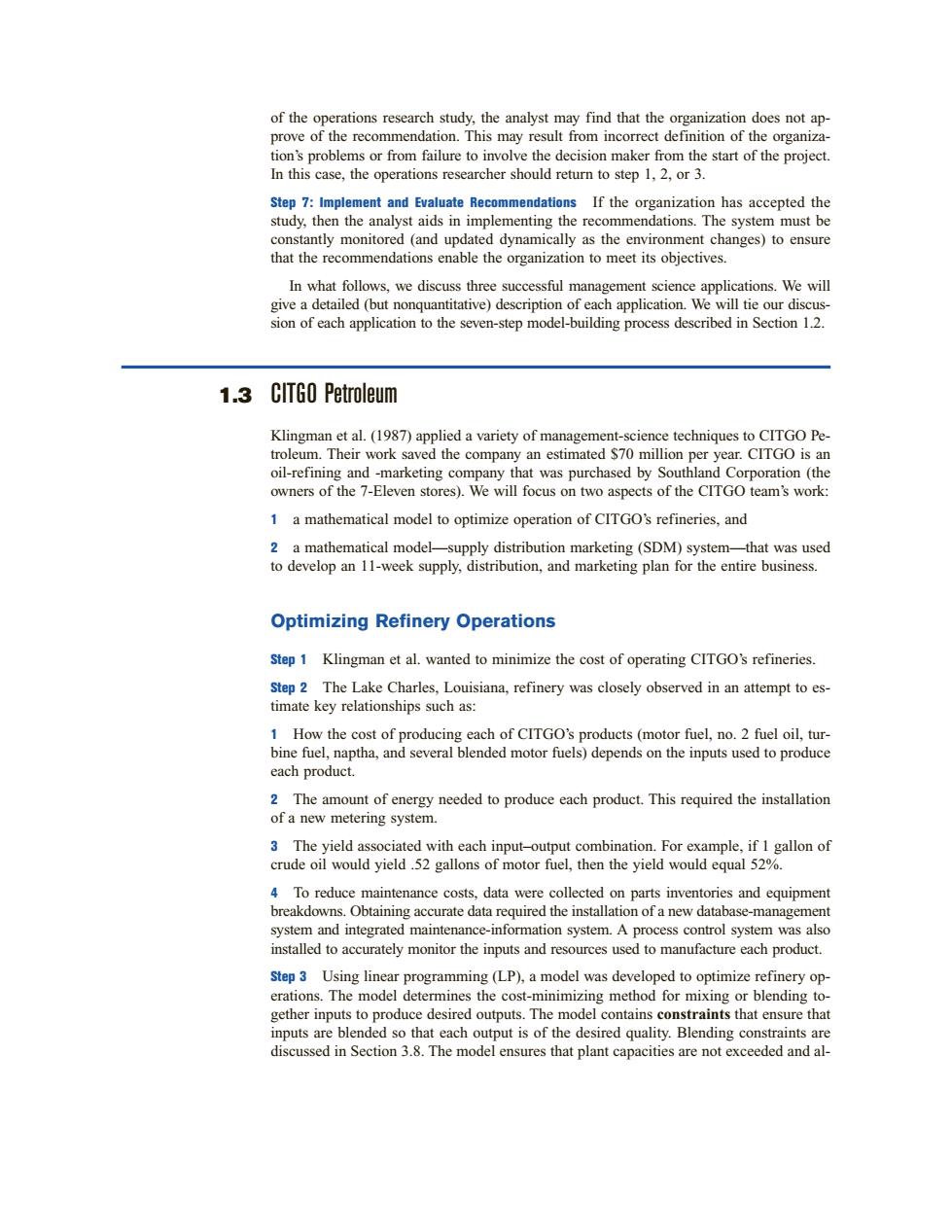正在加载图片...

of the operations research study,the analyst may find that the organization does not ap- prove of the recommendation.This may result from incorrect definition of the organiza- tion's problems or from failure to involve the decision maker from the start of the project. In this case,the operations researcher should return to step 1,2,or 3. Step 7:Implement and Evaluate Recommendations If the organization has accepted the study,then the analyst aids in implementing the recommendations.The system must be constantly monitored (and updated dynamically as the environment changes)to ensure that the recommendations enable the organization to meet its objectives. In what follows,we discuss three successful management science applications.We will give a detailed(but nonquantitative)description of each application.We will tie our discus- sion of each application to the seven-step model-building process described in Section 1.2. 1.3 CITGO Petroleum Klingman et al.(1987)applied a variety of management-science techniques to CITGO Pe- troleum.Their work saved the company an estimated $70 million per year.CITGO is an oil-refining and-marketing company that was purchased by Southland Corporation(the owners of the 7-Eleven stores).We will focus on two aspects of the CITGO team's work: 1 a mathematical model to optimize operation of CITGO's refineries,and 2 a mathematical model-supply distribution marketing(SDM)system-that was used to develop an 11-week supply,distribution,and marketing plan for the entire business. Optimizing Refinery Operations Step 1 Klingman et al.wanted to minimize the cost of operating CITGO's refineries. Step 2 The Lake Charles,Louisiana,refinery was closely observed in an attempt to es- timate key relationships such as: 1 How the cost of producing each of CITGO's products (motor fuel,no.2 fuel oil,tur- bine fuel,naptha,and several blended motor fuels)depends on the inputs used to produce each product. 2 The amount of energy needed to produce each product.This required the installation of a new metering system 3 The yield associated with each input-output combination.For example,if 1 gallon of crude oil would yield.52 gallons of motor fuel,then the yield would equal 52%. 4 To reduce maintenance costs,data were collected on parts inventories and equipment breakdowns.Obtaining accurate data required the installation of a new database-management system and integrated maintenance-information system.A process control system was also installed to accurately monitor the inputs and resources used to manufacture each product. Step 3 Using linear programming(LP),a model was developed to optimize refinery op- erations.The model determines the cost-minimizing method for mixing or blending to- gether inputs to produce desired outputs.The model contains constraints that ensure that inputs are blended so that each output is of the desired quality.Blending constraints are discussed in Section 3.8.The model ensures that plant capacities are not exceeded and al-of the operations research study, the analyst may find that the organization does not approve of the recommendation. This may result from incorrect definition of the organization’s problems or from failure to involve the decision maker from the start of the project. In this case, the operations researcher should return to step 1, 2, or 3. Step 7: Implement and Evaluate Recommendations If the organization has accepted the study, then the analyst aids in implementing the recommendations. The system must be constantly monitored (and updated dynamically as the environment changes) to ensure that the recommendations enable the organization to meet its objectives. In what follows, we discuss three successful management science applications. We will give a detailed (but nonquantitative) description of each application. We will tie our discussion of each application to the seven-step model-building process described in Section 1.2. 1.3 CITGO Petroleum Klingman et al. (1987) applied a variety of management-science techniques to CITGO Petroleum. Their work saved the company an estimated $70 million per year. CITGO is an oil-refining and -marketing company that was purchased by Southland Corporation (the owners of the 7-Eleven stores). We will focus on two aspects of the CITGO team’s work: 1 a mathematical model to optimize operation of CITGO’s refineries, and 2 a mathematical model—supply distribution marketing (SDM) system—that was used to develop an 11-week supply, distribution, and marketing plan for the entire business. Optimizing Refinery Operations Step 1 Klingman et al. wanted to minimize the cost of operating CITGO’s refineries. Step 2 The Lake Charles, Louisiana, refinery was closely observed in an attempt to estimate key relationships such as: 1 How the cost of producing each of CITGO’s products (motor fuel, no. 2 fuel oil, turbine fuel, naptha, and several blended motor fuels) depends on the inputs used to produce each product. 2 The amount of energy needed to produce each product. This required the installation of a new metering system. 3 The yield associated with each input–output combination. For example, if 1 gallon of crude oil would yield .52 gallons of motor fuel, then the yield would equal 52%. 4 To reduce maintenance costs, data were collected on parts inventories and equipment breakdowns. Obtaining accurate data required the installation of a new database-management system and integrated maintenance-information system. A process control system was also installed to accurately monitor the inputs and resources used to manufacture each product. Step 3 Using linear programming (LP), a model was developed to optimize refinery operations. The model determines the cost-minimizing method for mixing or blending together inputs to produce desired outputs. The model contains constraints that ensure that inputs are blended so that each output is of the desired quality. Blending constraints are discussed in Section 3.8. The model ensures that plant capacities are not exceeded and al- 6 CHAPTER 1 An Introduction to Model Building